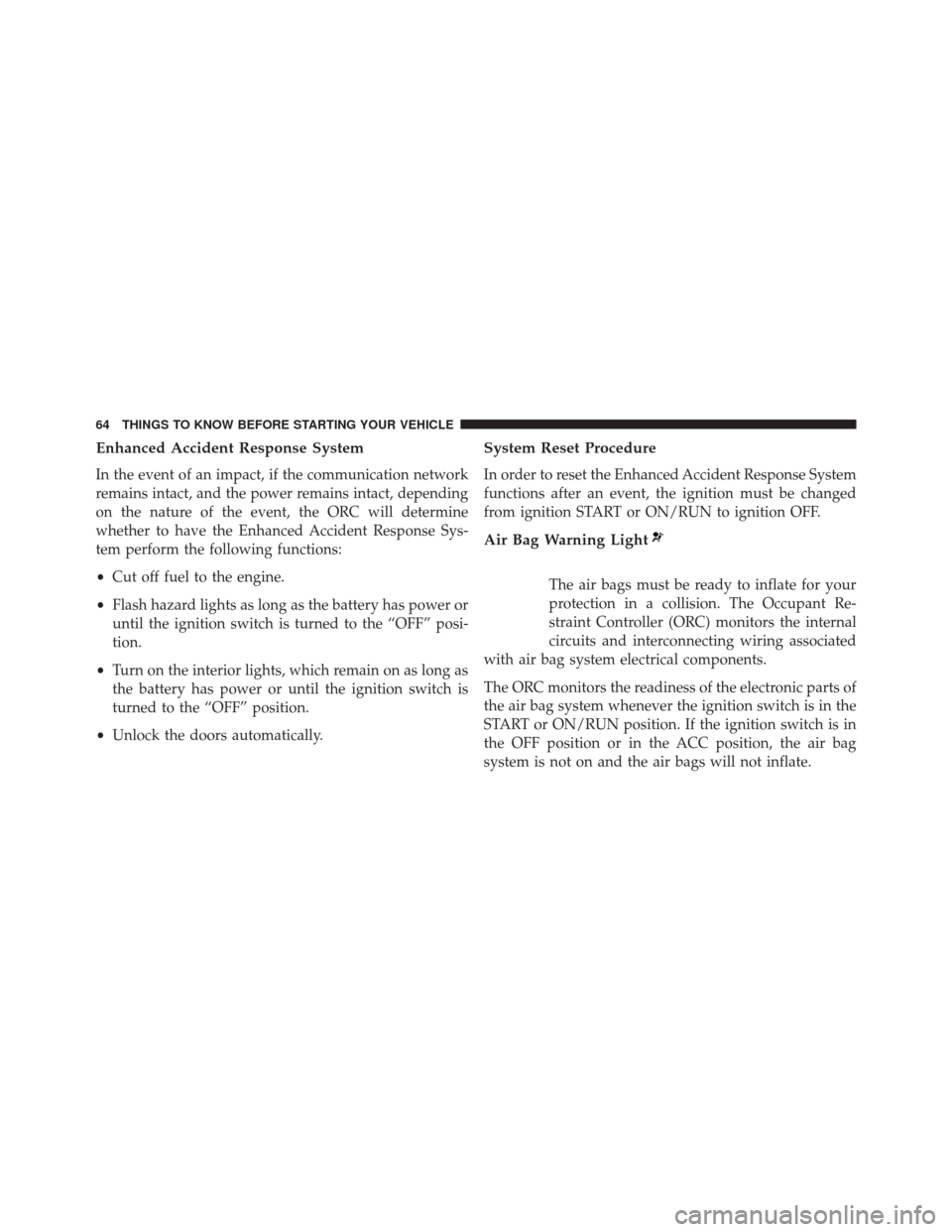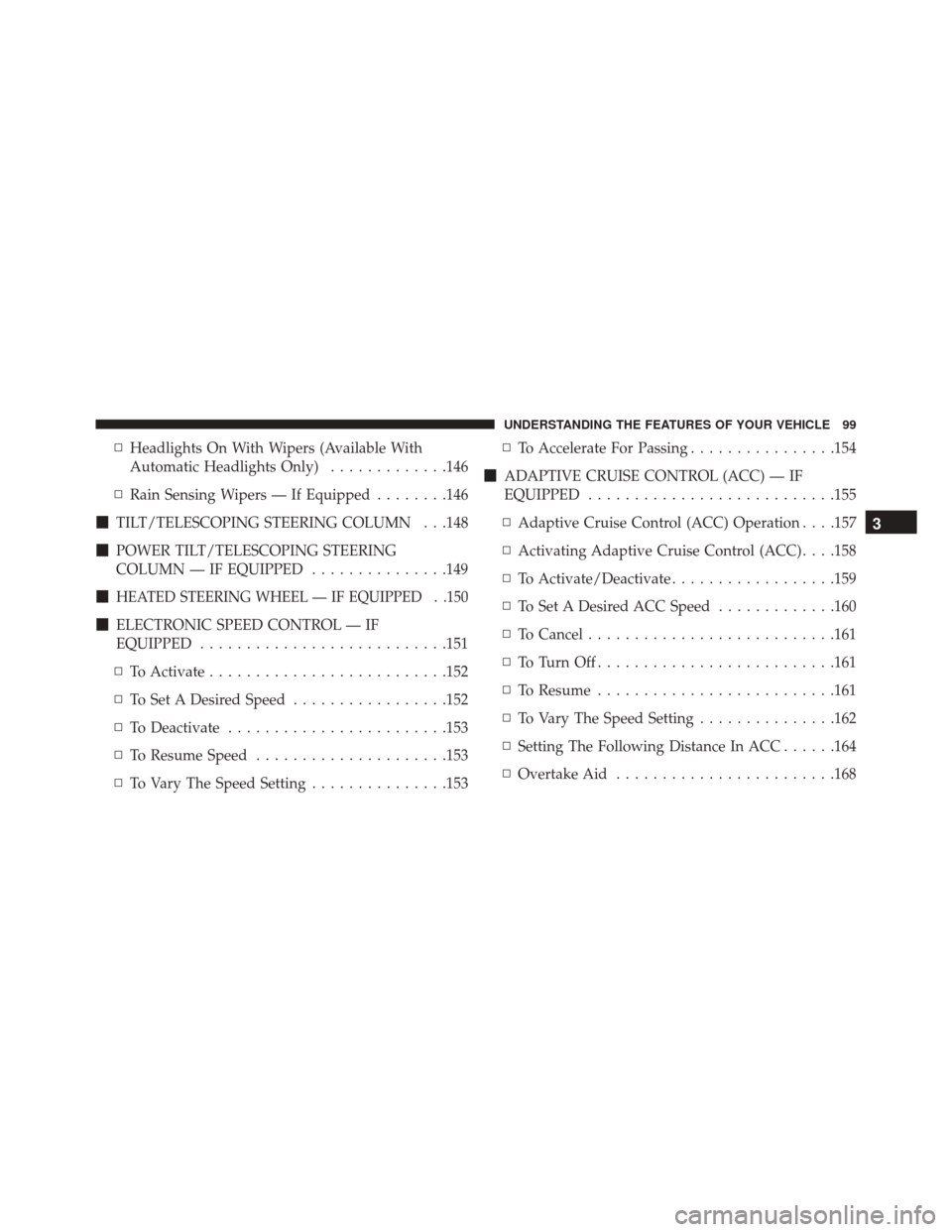Page 59 of 575

Because air bag sensors measure vehicle deceleration
over time, vehicle speed and damage by themselves are
not good indicators of whether or not an air bag should
have deployed.
Seat belts are necessary for your protection in all colli-
sions, and also are needed to help keep you in position,
away from an inflating air bag.
When the ORC detects a collision requiring the Ad-
vanced Front Air Bags, it signals the inflator units. A large
quantity of non-toxic gas is generated to inflate the
Advanced Front Air Bags.
The steering wheel hub trim cover and the upper right
side of the instrument panel separate and fold out of the
way as the air bags inflate to their full size. The Advanced
Front Air Bags fully inflate in less time than it takes to
blink your eyes. The air bags then quickly deflate while
helping to restrain the driver and front passenger.Knee Impact Bolsters
The Knee Impact Bolsters help protect the knees of the
driver and front passenger, and position the front occu-
pants for improved interaction with the Advanced Front
Air Bags.
WARNING!
•Do not drill, cut, or tamper with the knee impact
bolsters in any way.
• Do not mount any accessories to the knee impact
bolsters such as alarm lights, stereos, citizen band
radios, etc.
Supplemental Side Air Bags
Your vehicle is equipped with two types of side air bags:
1. Supplemental Seat-Mounted Side Air Bags (SABs): Located in the outboard side of the front seats. The
2
THINGS TO KNOW BEFORE STARTING YOUR VEHICLE 57
Page 66 of 575

Enhanced Accident Response System
In the event of an impact, if the communication network
remains intact, and the power remains intact, depending
on the nature of the event, the ORC will determine
whether to have the Enhanced Accident Response Sys-
tem perform the following functions:
•Cut off fuel to the engine.
• Flash hazard lights as long as the battery has power or
until the ignition switch is turned to the “OFF” posi-
tion.
• Turn on the interior lights, which remain on as long as
the battery has power or until the ignition switch is
turned to the “OFF” position.
• Unlock the doors automatically.
System Reset Procedure
In order to reset the Enhanced Accident Response System
functions after an event, the ignition must be changed
from ignition START or ON/RUN to ignition OFF.
Air Bag Warning Light
The air bags must be ready to inflate for your
protection in a collision. The Occupant Re-
straint Controller (ORC) monitors the internal
circuits and interconnecting wiring associated
with air bag system electrical components.
The ORC monitors the readiness of the electronic parts of
the air bag system whenever the ignition switch is in the
START or ON/RUN position. If the ignition switch is in
the OFF position or in the ACC position, the air bag
system is not on and the air bags will not inflate.
64 THINGS TO KNOW BEFORE STARTING YOUR VEHICLE
Page 97 of 575
Periodic Safety Checks You Should Make Outside
The Vehicle
Tires
Examine tires for excessive tread wear and uneven wear
patterns. Check for stones, nails, glass, or other objects
lodged in the tread or sidewall. Inspect the tread for cuts
and cracks. Inspect sidewalls for cuts, cracks, and bulges.
Check the wheel nuts for tightness. Check the tires
(including spare) for proper cold inflation pressure.
Lights
Have someone observe the operation of brake lights and
exterior lights while you work the controls. Check turn
signal and high beam indicator lights on the instrument
panel.
Door Latches
Check for proper closing, latching, and locking.
Fluid Leaks
Check area under vehicle after overnight parking for fuel,
engine coolant, oil, or other fluid leaks. Also, if gasoline
fumes are detected or if fuel, power steering fluid (if
equipped), or brake fluid leaks are suspected. The cause
should be located and corrected immediately.
2
THINGS TO KNOW BEFORE STARTING YOUR VEHICLE 95
Page 100 of 575

▫Manual Front Seatback Recline ............127
▫ Passenger Seat Easy Entry ...............128
▫ Head Restraints ..................... .129
▫ Folding Rear Seat .....................131
� TO OPEN AND CLOSE THE HOOD .........132
� LIGHTS ............................ .134
▫ Headlight Switch .....................134
▫ Automatic Headlights — If Equipped .......135
▫ Headlights On With Wipers (Available With
Automatic Headlights Only) .............136
▫ Automatic High Beam — If Equipped ......136
▫ Headlight Time Delay ..................137
▫ Daytime Running Lights (DRL) —
If Equipped ........................ .138▫
Lights-On Reminder ...................138
▫ Multifunction Lever ...................139
▫ Turn Signals ........................ .139
▫ Lane Change Assist ...................140
▫ High/Low Beam Switch ................140
▫ Flash-To-Pass ....................... .140
▫ Map/Reading Lights ...................141
▫ Interior Lights ...................... .142
� WINDSHIELD WIPERS AND WASHERS ......143
▫ Intermittent Wiper System ...............144
▫ Mist Feature ........................ .145
▫ Windshield Washers ...................145
98 UNDERSTANDING THE FEATURES OF YOUR VEHICLE
Page 101 of 575

▫Headlights On With Wipers (Available With
Automatic Headlights Only) .............146
▫ Rain Sensing Wipers — If Equipped ........146
� TILT/TELESCOPING STEERING COLUMN . . .148
� POWER TILT/TELESCOPING STEERING
COLUMN — IF EQUIPPED ...............149
�
HEATED STEERING WHEEL — IF EQUIPPED . .150
� ELECTRONIC SPEED CONTROL — IF
EQUIPPED .......................... .151
▫ To Activate ......................... .152
▫ To Set A Desired Speed .................152
▫ To Deactivate ....................... .153
▫ To Resume Speed .....................153
▫ To Vary The Speed Setting ...............153 ▫
To Accelerate For Passing ................154
� ADAPTIVE CRUISE CONTROL (ACC) — IF
EQUIPPED .......................... .155
▫ Adaptive Cruise Control (ACC) Operation . . . .157
▫ Activating Adaptive Cruise Control (ACC) . . . .158
▫ To Activate/Deactivate ..................159
▫ To Set A Desired ACC Speed .............160
▫ To Cancel .......................... .161
▫ ToTurnOff......................... .161
▫ To Resume ......................... .161
▫ To Vary The Speed Setting ...............162
▫ Setting The Following Distance In ACC ......164
▫ Overtake Aid ....................... .168
3
UNDERSTANDING THE FEATURES OF YOUR VEHICLE 99
Page 102 of 575

▫Adaptive Cruise Control (ACC) Menu .......168
▫ Display Warnings And Maintenance ........169
▫ Precautions While Driving With ACC .......171
▫ General Information ....................175
▫ Normal (Fixed Speed) Electronic Speed Control
Mode ............................. .176
� FORWARD COLLISION WARNING (FCW) — IF
EQUIPPED .......................... .180
▫
Forward Collision Warning (FCW) Operation . . .180
▫ Turning FCW ON Or OFF ...............181
▫ Changing FCW Status ..................182
▫ Service FCW Warning ..................183
� PARKSENSE® REAR PARK ASSIST — IF
EQUIPPED .......................... .183▫
ParkSense® Sensors ....................183
▫ ParkSense® Warning Display .............184
▫ ParkSense® Display ....................184
▫ Enabling And Disabling ParkSense® ........188
▫ Service The ParkSense® Rear Park Assist
System ............................ .189
▫ Cleaning The ParkSense® System ..........190
▫ ParkSense® System Usage Precautions .......190
� PARKVIEW® REAR BACK UP CAMERA — IF
EQUIPPED .......................... .192
� OVERHEAD CONSOLE ..................194
▫ Courtesy/Reading Lights ...............195
▫ Sunglasses Storage ....................195
� GARAGE DOOR OPENER — IF EQUIPPED . . .195
100 UNDERSTANDING THE FEATURES OF YOUR VEHICLE
Page 122 of 575

Modes Of Operation
Three selectable modes of operation are available in the
Uconnect® System. Refer to “Uconnect® Settings” in
“Understanding Your Instrument Panel” for further in-
formation.
Blind Spot Alert Lights Only
When operating in Blind Spot Alert mode, the BSM
system will provide a visual alert in the appropriate side
view mirror based on a detected object. However, when
the system is operating in Rear Cross Path mode, the
system will respond with both visual and audible alerts
when a detected object is present. Whenever an audible
alert is requested, the radio volume is reduced.
Blind Spot Alert Lights/Chime
When operating in Blind Spot Alert Lights/Chime mode,
the BSM system will provide a visual alert in the appro-
priate side view mirror based on a detected object. If theturn signal is then activated, and it corresponds to an
alert present on that side of the vehicle, an audible chime
will also be sounded. Whenever a turn signal and de-
tected object are present on the same side at the same
time, both the visual and audio alerts will be issued. In
addition to the audible alert the radio (if on) volume will
be reduced.
NOTE:
•
Whenever an audible alert is requested by the BSM
system, the radio volume is reduced.
• If the hazard flashers are on, the system will request
the appropriate visual alert only.
When the system is in RCP, the system shall respond with
both visual and audible alerts when a detected object is
present. Whenever an audible alert is requested, the radio
volume is reduced. Turn/hazard signal status is ignored;
the RCP state always requests the chime.
120 UNDERSTANDING THE FEATURES OF YOUR VEHICLE
Page 136 of 575
CAUTION!
To prevent possible damage, do not slam the hood to
close it. Lower the hood until it is open approxi-
mately 6 inches (15 cm), and then drop it. This should
(Continued)
CAUTION!(Continued)
secure both latches. Never drive your vehicle unless
the hood is fully closed, with both latches engaged.
WARNING!
Be sure the hood is fully latched before driving your
vehicle. If the hood is not fully latched, it could open
when the vehicle is in motion and block your vision.
Failure to follow this warning could result in serious
injury or death.
LIGHTS
Headlight Switch
The headlight switch is located on the left side of
the instrument panel. This switch controls the
Hood Safety Catch
134 UNDERSTANDING THE FEATURES OF YOUR VEHICLE